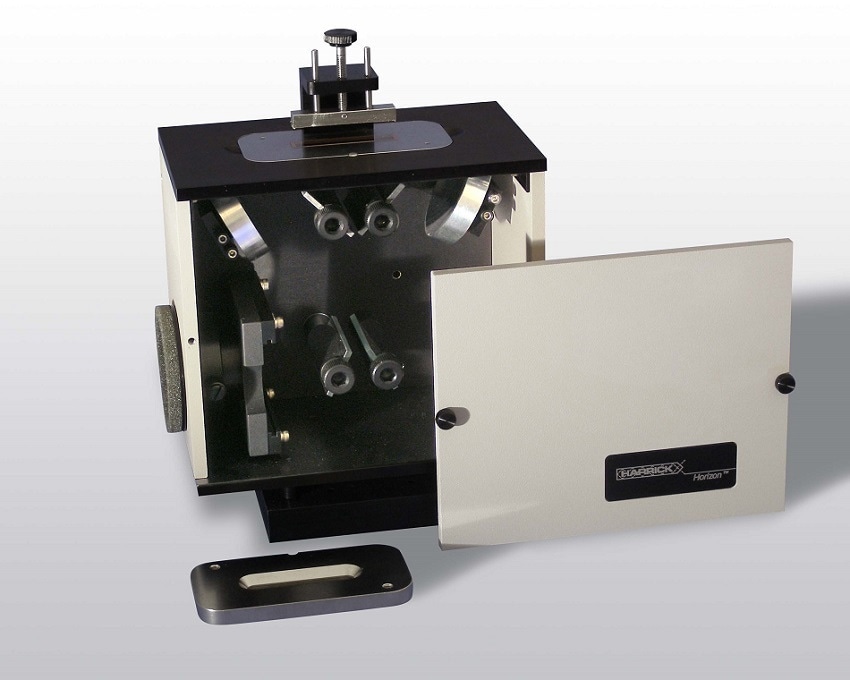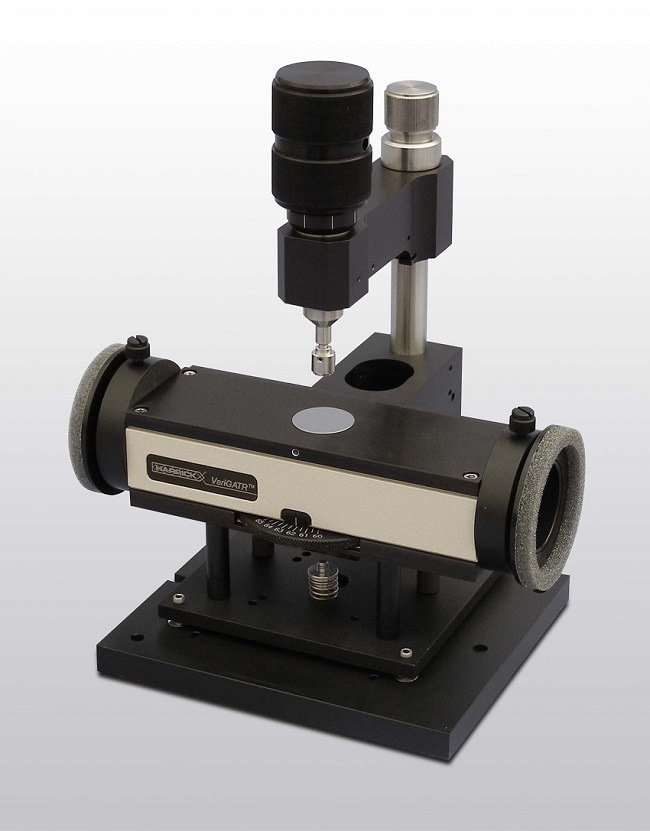 Interview conducted by Mychealla RiceJul 12 2017
Interview conducted by Mychealla RiceJul 12 2017In this Interview, Sue Berets, Application Scientist from Harrick Scientific talks to AZoM about Polarization and why Harrick Scientific produces many of its accessories polarizer ready.
Please tell us a bit about Harrick Scientific and the work you do?
Harrick Scientific manufactures a full line of spectroscopic accessories and optics for transmission, specular reflection, diffuse reflection, and ATR for the mid-IR, UV/Vis and NIR. My work as an applications scientist includes technical support both before and after sales.
This includes testing samples to make recommendations for suitable equipment to fulfil the applications requirement of the customer, assisting in setting up the equipment so it is operational and providing tips to the customers to make the most out of their equipment. In addition, I’m involved in research and development, both in applications and for new products.

What is Polarization?
Polarization is a property describing the geometric orientation of the oscillations of an electric field. Light is an electromagnetic wave with an electric field that oscillates perpendicular to the direction of propagation.
If the direction of this electric field fluctuates randomly with time, then the light is called unpolarized. If the direction of the electric field is well defined, it is considered polarized. Common unpolarized light sources include the sun, incandescent bulbs, etc. The most commonly used polarized light source is a laser, although not all lasers are polarized.
For optical spectroscopy – transmission, reflection and ATR, the two perpendicular linear polarizations are the most important. These are referred to as p-polarization, where the electric field is polarized parallel to the plane of incidence, and s-polarization, where the field is perpendicular to this plane. The plane of incidence is the plane that contains the incoming and reflected rays as well as the normal to the sample surface.
Why does Harrick Scientific produce many of its accessories polarizer ready?
The spectroscopic measureable – transmission, reflection or ATR – is a function of polarization, incident angle, wavelength and fundamental properties of the sample.
As a result, many of our accessories are polarizer-ready. Polarizers can be used with our accessories for tighter control of the incident polarization and also to extract additional information about the sample.

What benefit does this add?
For some materials, using a polarizer can provide additional information about the sample.
- For transmission measurements of thin films, measuring the spectra at Brewster’s angle with a polarizer eliminates interference fringes.
- Polarizers can also be used to help determine refractive index and thickness.
- For polymers, films and fibers, polarization can be used to detect or monitor orientation.
- Coatings on Si wafers can be examined using a polarizer to also determine the orientation of functional groups on the surface of the substrate. This is useful for applications where the surface of the substrate is being tailored to react in a specific manner.
- Polarizers are also used in the development and production of optical coatings, to inspect the optic to ensure the performance of the coating.
- Polarizers are also useful when comparing data collected by different spectrometers. Most spectrometers have a polarization bias and it differs from one spectrometer make/model to another.
What types of polarizers are there and how are they used?
There are a number of different types of polarizers on the market and they are all used for similar applications as mentioned above. The differences between the polarizers are how efficiently they polarize the incoming light.
- Wire grid polarizers are the best choice for use with commercial IR/UV-Vis/NIR spectrometers. Most wire grid polarizers are deposited on substrates, since the wire grid itself is very fragile. The wire grids in this case are either holographically deposited or ruled. Free-standing wire grid polarizers are primarily used for FIR or THz measurements.
- The Glan Taylor, Glan Thompson, Glan Laser, Rochon and Wollaston Polarizers are made from two prisms made from birefringent materials. These polarizers generally have a much higher efficiency or degree of polarization than the typical wire grid polarizers. However, because of their design, they only provide a high degree of polarization when the incident light is within a relatively narrow angular range. This means that these polarizers work best for laser applications or spectrometers with a virtually collimated beam.
How can you determine the orientation of the polarizer?
Many of the polarizers used for optical spectroscopy measurements are labelled with a rotating scale. For wire grid polarizers, the direction of the grid is not visible which can make it difficult to determine how to orient the polarizer.
There are a few tricks that can be used to determine the orientation of the grid or the polarization. For grazing angle specular reflectance, p-polarization gives a much stronger signal than s-polarization. For ATR at a 45 incident angle, the absorbance from a sample measured with p-polarization is twice as strong as that measured with s-polarization.

Can you give us any case studies?
There are many examples of the types of information that can be gleaned with the use of a polarizer in the literature. Two which are particularly interesting are their use in determining the orientation of polymers and the orientation of functional groups on substrates.
During the manufacturing process, plastics are frequently stretched along an axis to orient the polymers. The oriented material has different optical and mechanical properties along the stretched axis and its perpendicular axis. A prime example of this is a soda bottle, where the manufacturing process stretches the plastic radially and axially for strength.
Several studies have been carried out using the Seagull variable angle reflection accessory with its ATR rotator and wire grid polarizer to determine the orientation of polymers. These include ATR Rotator for Studies of Oriented Samples Characterization of “Skin” Orientation of Thermotropic Liquid Crystalline Copolyester Moldings.
Coatings and self-assembled monolayers are frequently deposited on silicon and metallic substrates to change the physical and chemical properties of the surfaces. The properties of the surface can depend on the orientation of the functional groups on the surface, whether they are parallel or perpendicular to the surface.
The orientation of the functional groups can be extracted from measurements collected with a polarizer. A specific example is shown in The Relationship Between Polarization and Sensitivity for Grazing Angle ATR Studies of Thin Coatings on Silicon, where the Vari GATR grazing angle ATR accessory was used along with its polarizer. However these are just two of the many applications where polarizers are used.
Where can our readers go to find out more?
Polarization is discussed in most texts on spectroscopy and many spectroscopic studies have been carried out using polarizers. Some useful references include:
- J. A. Mielczarski, M. Milosevic, and S. L. Berets, "Optical Properties of Strongly Absorbing Media Determined by External Reflection Spectroscopy," Appl. Spectrosc. 46, 1040-1044 (1992)
- S. L. Berets and Milan Milosevic, “Extracting Infrared Absolute Reflectance from Relative Reflectance Measurements,” Appl. Spectrosc. 66(6), 680-684 (2012)
- The Influence of Refractive Index on the Efficacy of Absolute Reflectance References
- N. J. Harrick: Internal Reflection Spectroscopy, Harrick Scientific Products, Inc., New York 1987.
- Wesley Wm. Wendtlandt, Harry G. Hecht: Reflectance Spectroscopy, John Wiley and Sons, New York, 1966.
- G. Kortum: Reflection Spectroscopy: Principles, Methods, Applications, Springer-Verlag New York Inc., 1969.
- P. R. Griffiths, J. A. de Haseth: Fourier Transform Infrared Spectroscopy, J. Wiley & Sons, New York 1986
- F. M. Mirabella (ed.): Modern Techiques in Applied Molecular Spectroscopy, J. Wiley & Sons, New York 1998.
About Sue Berets
Sue received a B.A. in chemistry with a minor in mathematics from Wellesley College, followed by a PhD in chemistry from Tufts University. After receiving a PhD, Sue joined Harrick Scientific as an applications scientist. Sue's work includes technical support; testing customer samples to make recommendations for suitable equipment to fulfil the applications requirements, assisting in equipment set up and writing technical documentation.
In addition, Sue provide's operating tips to customers to optimize the performance of their equipment for their application. Sue is also involved in applications and new product research and development.
Disclaimer: The views expressed here are those of the interviewee and do not necessarily represent the views of AZoM.com Limited (T/A) AZoNetwork, the owner and operator of this website. This disclaimer forms part of the Terms and Conditions of use of this website.